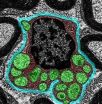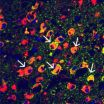(Press-News.org) JACKSONVILLE, Fla. — A pair of studies tells the tale of how a neuroscientist at Mayo Clinic in Florida helped to discover the first African-American family to have inherited the rare movement disorder dystonia, which causes repetitive muscle contractions and twisting, resulting in abnormal posture. The research may improve diagnosis of this neurological condition in a population not known to suffer from it.
In the first study, published in 2011 in the journal Parkinsonism and Related Disorders, Mayo Clinic's Zbigniew Wszolek, M.D., and a team of neuroscientists from other institutions in the U.S. described three generations of an African-American family in Georgia who had dystonia. The team excluded mutations in genes previously associated with dystonia. The study was the first description of an African-American family with late-onset primary dystonia.
In the second study, published online this week in Human Molecular Genetics, Dr. Wszolek was part of an international team of researchers led by Mark LeDoux, M.D., Ph.D., a neurologist and neurogeneticist from the University of Tennessee Health Science Center in Memphis. The investigators identified the specific genetic abnormality seen in the African-American family and in several other white families. In the African-American family, the mutation produced a protein in which one amino acid was substituted for another.
While this isn't the only gene anomaly linked to dystonia, it is the first found in an African-American family. All other genes found to be linked to this disorder were discovered in families of other ethnic origins.
The findings may improve diagnosis and treatment of dystonia in African-Americans, says Dr. Wszolek, who has been a driving force behind international research efforts to uncover genes that play a role in neurological disorders.
"This is a very hard disease to diagnose," Dr. Wszolek says. "The patient who came to see me had been to many other physicians who did not help him. His disorder, which resulted in contortions of his upper body, led to the loss of his job, and it meant that he couldn't drive because he was not able to keep his head straight to see in front of him," Dr. Wszolek says.
Through work with the patient, Dr. Wszolek came to know the rest of his family, which allowed him to do the genetic work that was critical to discovery of the mutated gene.
When dystonia was finally diagnosed in the patient, Dr. Wszolek and the Mayo Clinic health care team treated him with botulinum toxin (also known as Botox) to reduce muscle spasms and improve his head position.
"Our study now tells physicians that dystonia can occur in African-American patients, and that a blood sample that reveals a genetic abnormality can help diagnose the disease," Dr. Wszolek says. "There is no cure, but treatment can really help. Now the patient has less pain, he can drive and he works part time."
###
Both clinical and genetic studies were supported, in part, by the Dystonia Medical Research Foundation.
About Mayo Clinic
Mayo Clinic is a nonprofit worldwide leader in medical care, research and education for people from all walks of life. For more information, visit http://www.mayoclinic.com and http://www.mayoclinic.org/news.
Journalists can become a member of the Mayo Clinic News Network for the latest health, science and research news and access to video, audio, text and graphic elements that can be downloaded or embedded.
Mayo Clinic aids discovery of first dystonia gene found in African-Americans
2013-03-07
ELSE PRESS RELEASES FROM THIS DATE:
Federal figures miss most work-related amputations
2013-03-07
A new report from Michigan State University and the Michigan Department of Community Health raises significant concerns about the federal government's system for tracking work-related injuries.
Published in the Journal of Occupational and Environmental Medicine, the study found the number of amputations following jobsite accidents in Michigan was nearly two-and-a-half times higher than the official estimate from the U.S. Bureau of Labor Statistics.
Such inaccuracy is evidence that the bureau should change its system that relies solely on a sample of employers to report ...
Protein lost in tumors blocks normal cells from being reprogrammed into stem cells
2013-03-07
Researchers from the Icahn School of Medicine at Mount Sinai have discovered that a particular protein prevents normal cells from being reprogrammed into cells that resemble stem cells, providing new insight into how they may lose their plasticity during normal development. This finding has broad-reaching implications for how cells change during both normal and disease development. The data are published this week in Nature Communications.
In a previous study, Emily Bernstein, PhD, and her team at Mount Sinai studied the natural progression of melanoma using mouse and ...
Researchers explain a key developmental mechanism for the first time in plants
2013-03-07
Cold Spring Harbor, NY -- The normal development of an animal or plant can be compared in at least two ways with the successful performance of a great symphony. The whole is the product of a great number of events involving contributions by many different "players"; and these contributions must occur in a precise and almost perfectly coordinated temporal and spatial sequence.
In simple animals like the fruit fly and more recently in plants and mammals, scientists have been able to identify some of the principal players in the developmental symphony. Today, a team ...
UTHealth researchers report prevalence of sexting among minority youth
2013-03-07
HOUSTON—(March 6, 2013)—Researchers at The University of Texas Health Science Center at Houston (UTHealth) have found that up to 30 percent of minority youths reported sending or receiving "sexts," which are sexually explicit messages sent through technology including photos, videos and text-only messages.
"Although sexting is relatively common among youth and there has been a lot of attention about sexting in the media, there hasn't been much about sexting among ethnic minority youth," said lead investigator Melissa Fleschler Peskin, Ph.D., assistant professor of behavioral ...
A sausage a day is too many
2013-03-07
This press release is available in German.
"We estimate that three percent of all premature deaths can be attributed to the high consumption of processed meat," summarizes Sabine Rohrmann from the Institute of Social and Preventive Medicine at the University of Zurich. Teaming up with research colleagues from ten countries, she has been studying the link between the consumption of processed meat and the risk of mortality as part of a Europe-wide study with around 450,000 participants.
People who eat a lot of processed meat such as sausage products, salami or ham ...
New clues to causes of peripheral nerve damage
2013-03-07
Anyone whose hand or foot has "fallen asleep" has an idea of the numbness and tingling often experienced by people with peripheral nerve damage. The condition also can cause a range of other symptoms, including unrelenting pain, stinging, burning, itching and sensitivity to touch.
Although peripheral neuropathies afflict some 20 million Americans, their underlying causes are not completely understood. Much research has focused on the breakdown of cellular energy factories in nerve cells as a contributing factor.
Now, new research at Washington University School of Medicine ...
Improving electronics by solving nearly century-old problem
2013-03-07
RIVERSIDE, Calif. (http://www.ucr.edu) — A University of California, Riverside Bourns College of Engineering professor and a team of researchers published a paper today that shows how they solved an almost century-old problem that could further help downscale the size of electronic devices.
The work, led by Alexander A. Balandin, a professor of electrical engineering at UC Riverside, focused on the low-frequency electronic 1/f noise, also known as pink noise and flicker noise. It is a signal or process with a power spectral density inversely proportional to the frequency. ...
Some brain cells are better virus fighters
2013-03-07
Viruses often spread through the brain in patchwork patterns, infecting some cells but missing others. New research at Washington University School of Medicine in St. Louis helps explain why. The scientists showed that natural immune defenses that resist viral infection are turned on in some brain cells but switched off in others.
"The cells that a pathogen infects can be a major determinant of the seriousness of brain infections," says senior author Michael Diamond, MD, PhD, professor of medicine. "To understand the basis of disease, it is important to understand which ...
Breaking the rules for how tsunamis work
2013-03-07
The earthquake zones off of certain coasts—like those of Japan and Java—make them especially vulnerable to tsunamis, according to a new study. They can produce a focusing point that creates massive and devastating tsunamis that break the rules for how scientists used to think tsunamis work.
Until now, it was largely believed that the maximum tsunami height onshore could not exceed the depth of the seafloor. But new research shows that when focusing occurs, that scaling relationship breaks down and flooding can be up to 50 percent deeper with waves that do not lose height ...
Scientists improve transgenic 'Enviropigs'
2013-03-07
A research team at the University of Guelph has developed a new line of transgenic "Enviropigs." The new line of pigs is called the Cassie line, and it is known for passing genes on more reliably. The results of this project were published ahead of print in the Journal of Animal Science.
Enviropigs have genetically modified salivary glands, which help them digest phosphorus in feedstuffs and reduce phosphorus pollution in the environment. After developing the initial line of Enviropigs, researchers found that the line had certain genes that could be unstable during reproduction ...

